SAS Visual Analytics for Health Data Analysis in US Health Department
VerifiedAdded on 2022/10/02
|8
|2753
|184
AI Summary
This document discusses the use of SAS Visual Analytics in US health departments for health data analysis. It highlights the benefits of using data visualizations and how they can be used to make effective decisions. The document also provides insights into the most popular diseases affecting the US population and recommendations for improving healthcare services.
Contribute Materials
Your contribution can guide someone’s learning journey. Share your
documents today.
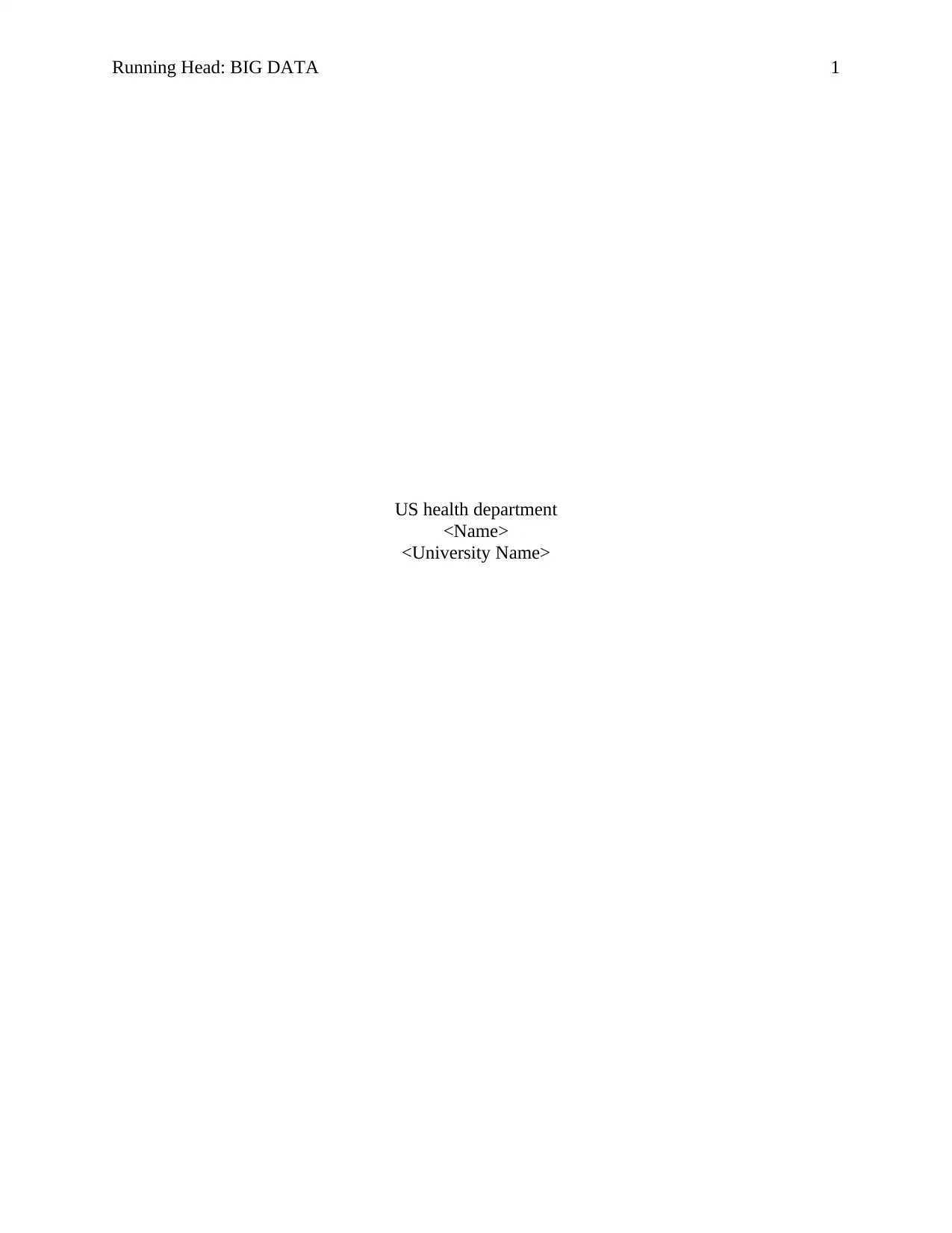
Running Head: BIG DATA 1
US health department
<Name>
<University Name>
US health department
<Name>
<University Name>
Secure Best Marks with AI Grader
Need help grading? Try our AI Grader for instant feedback on your assignments.
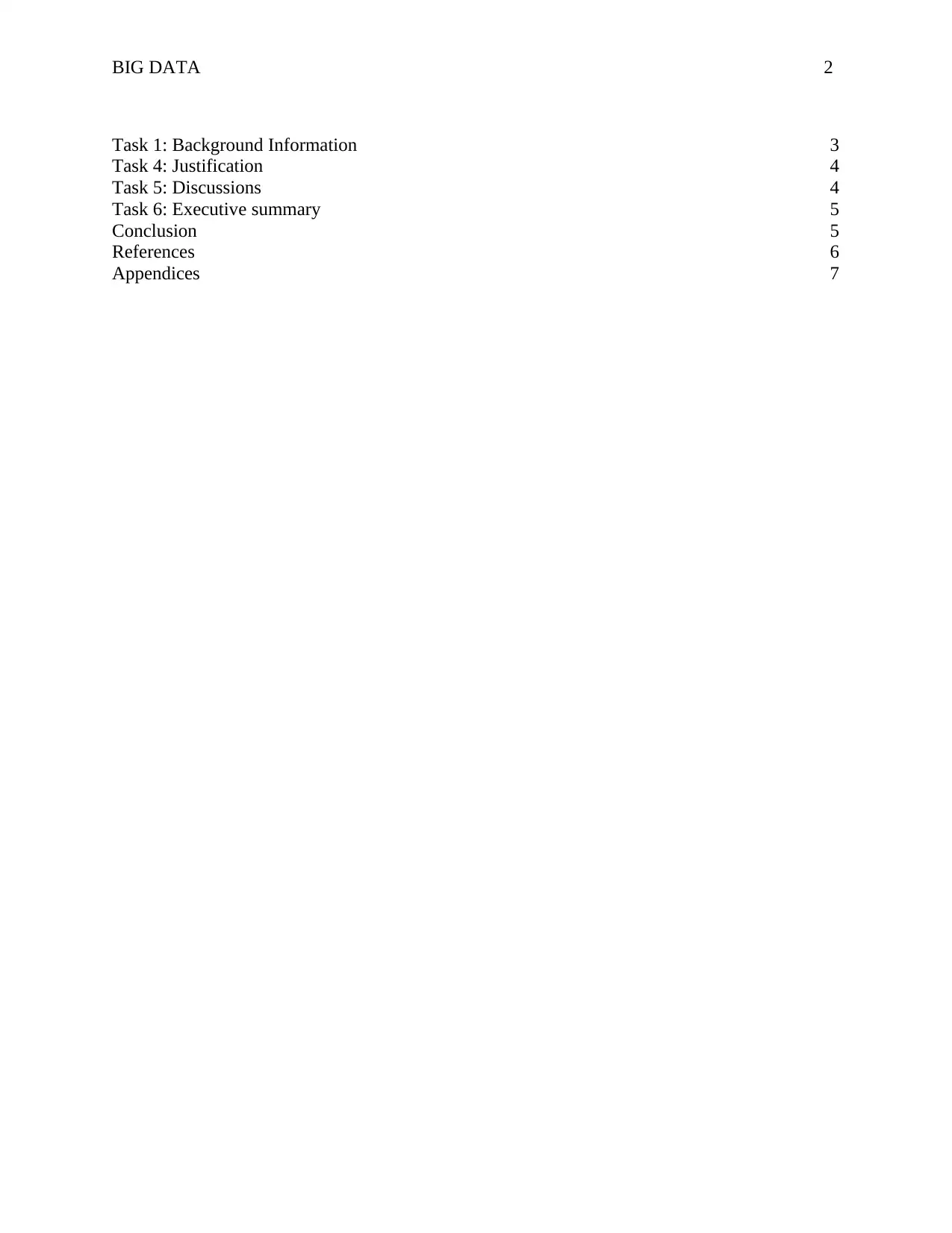
BIG DATA 2
Task 1: Background Information 3
Task 4: Justification 4
Task 5: Discussions 4
Task 6: Executive summary 5
Conclusion 5
References 6
Appendices 7
Task 1: Background Information 3
Task 4: Justification 4
Task 5: Discussions 4
Task 6: Executive summary 5
Conclusion 5
References 6
Appendices 7
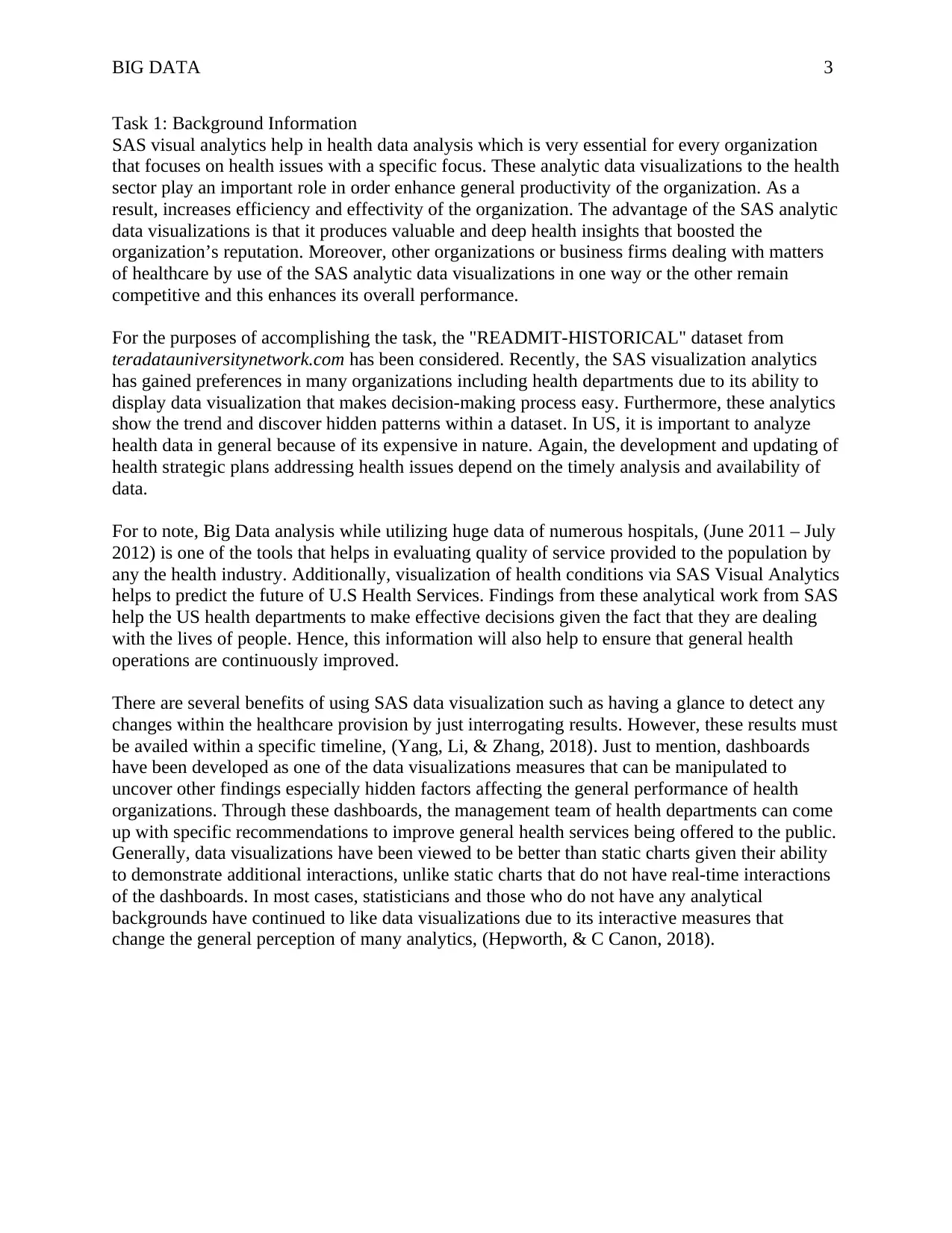
BIG DATA 3
Task 1: Background Information
SAS visual analytics help in health data analysis which is very essential for every organization
that focuses on health issues with a specific focus. These analytic data visualizations to the health
sector play an important role in order enhance general productivity of the organization. As a
result, increases efficiency and effectivity of the organization. The advantage of the SAS analytic
data visualizations is that it produces valuable and deep health insights that boosted the
organization’s reputation. Moreover, other organizations or business firms dealing with matters
of healthcare by use of the SAS analytic data visualizations in one way or the other remain
competitive and this enhances its overall performance.
For the purposes of accomplishing the task, the "READMIT-HISTORICAL" dataset from
teradatauniversitynetwork.com has been considered. Recently, the SAS visualization analytics
has gained preferences in many organizations including health departments due to its ability to
display data visualization that makes decision-making process easy. Furthermore, these analytics
show the trend and discover hidden patterns within a dataset. In US, it is important to analyze
health data in general because of its expensive in nature. Again, the development and updating of
health strategic plans addressing health issues depend on the timely analysis and availability of
data.
For to note, Big Data analysis while utilizing huge data of numerous hospitals, (June 2011 – July
2012) is one of the tools that helps in evaluating quality of service provided to the population by
any the health industry. Additionally, visualization of health conditions via SAS Visual Analytics
helps to predict the future of U.S Health Services. Findings from these analytical work from SAS
help the US health departments to make effective decisions given the fact that they are dealing
with the lives of people. Hence, this information will also help to ensure that general health
operations are continuously improved.
There are several benefits of using SAS data visualization such as having a glance to detect any
changes within the healthcare provision by just interrogating results. However, these results must
be availed within a specific timeline, (Yang, Li, & Zhang, 2018). Just to mention, dashboards
have been developed as one of the data visualizations measures that can be manipulated to
uncover other findings especially hidden factors affecting the general performance of health
organizations. Through these dashboards, the management team of health departments can come
up with specific recommendations to improve general health services being offered to the public.
Generally, data visualizations have been viewed to be better than static charts given their ability
to demonstrate additional interactions, unlike static charts that do not have real-time interactions
of the dashboards. In most cases, statisticians and those who do not have any analytical
backgrounds have continued to like data visualizations due to its interactive measures that
change the general perception of many analytics, (Hepworth, & C Canon, 2018).
Task 1: Background Information
SAS visual analytics help in health data analysis which is very essential for every organization
that focuses on health issues with a specific focus. These analytic data visualizations to the health
sector play an important role in order enhance general productivity of the organization. As a
result, increases efficiency and effectivity of the organization. The advantage of the SAS analytic
data visualizations is that it produces valuable and deep health insights that boosted the
organization’s reputation. Moreover, other organizations or business firms dealing with matters
of healthcare by use of the SAS analytic data visualizations in one way or the other remain
competitive and this enhances its overall performance.
For the purposes of accomplishing the task, the "READMIT-HISTORICAL" dataset from
teradatauniversitynetwork.com has been considered. Recently, the SAS visualization analytics
has gained preferences in many organizations including health departments due to its ability to
display data visualization that makes decision-making process easy. Furthermore, these analytics
show the trend and discover hidden patterns within a dataset. In US, it is important to analyze
health data in general because of its expensive in nature. Again, the development and updating of
health strategic plans addressing health issues depend on the timely analysis and availability of
data.
For to note, Big Data analysis while utilizing huge data of numerous hospitals, (June 2011 – July
2012) is one of the tools that helps in evaluating quality of service provided to the population by
any the health industry. Additionally, visualization of health conditions via SAS Visual Analytics
helps to predict the future of U.S Health Services. Findings from these analytical work from SAS
help the US health departments to make effective decisions given the fact that they are dealing
with the lives of people. Hence, this information will also help to ensure that general health
operations are continuously improved.
There are several benefits of using SAS data visualization such as having a glance to detect any
changes within the healthcare provision by just interrogating results. However, these results must
be availed within a specific timeline, (Yang, Li, & Zhang, 2018). Just to mention, dashboards
have been developed as one of the data visualizations measures that can be manipulated to
uncover other findings especially hidden factors affecting the general performance of health
organizations. Through these dashboards, the management team of health departments can come
up with specific recommendations to improve general health services being offered to the public.
Generally, data visualizations have been viewed to be better than static charts given their ability
to demonstrate additional interactions, unlike static charts that do not have real-time interactions
of the dashboards. In most cases, statisticians and those who do not have any analytical
backgrounds have continued to like data visualizations due to its interactive measures that
change the general perception of many analytics, (Hepworth, & C Canon, 2018).
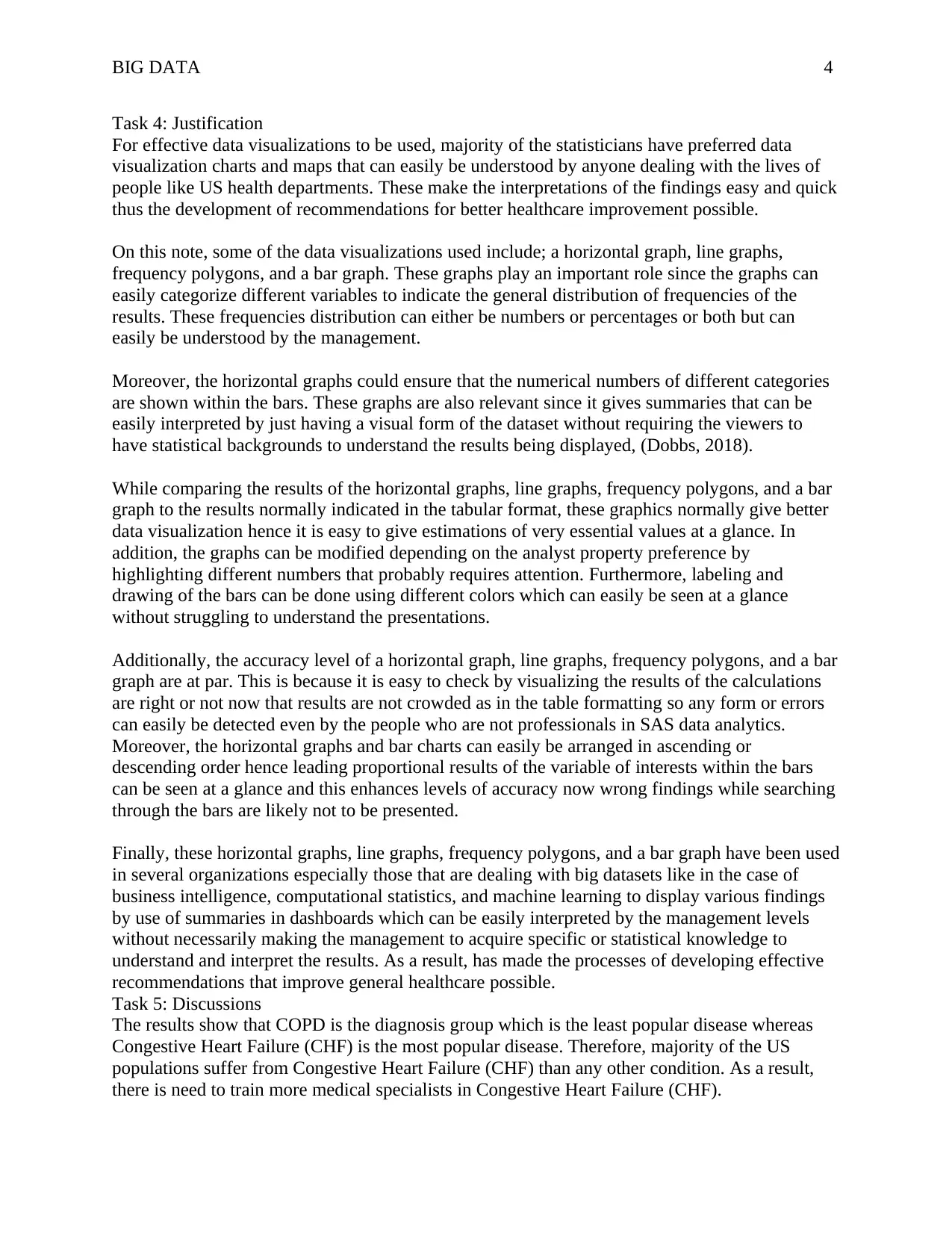
BIG DATA 4
Task 4: Justification
For effective data visualizations to be used, majority of the statisticians have preferred data
visualization charts and maps that can easily be understood by anyone dealing with the lives of
people like US health departments. These make the interpretations of the findings easy and quick
thus the development of recommendations for better healthcare improvement possible.
On this note, some of the data visualizations used include; a horizontal graph, line graphs,
frequency polygons, and a bar graph. These graphs play an important role since the graphs can
easily categorize different variables to indicate the general distribution of frequencies of the
results. These frequencies distribution can either be numbers or percentages or both but can
easily be understood by the management.
Moreover, the horizontal graphs could ensure that the numerical numbers of different categories
are shown within the bars. These graphs are also relevant since it gives summaries that can be
easily interpreted by just having a visual form of the dataset without requiring the viewers to
have statistical backgrounds to understand the results being displayed, (Dobbs, 2018).
While comparing the results of the horizontal graphs, line graphs, frequency polygons, and a bar
graph to the results normally indicated in the tabular format, these graphics normally give better
data visualization hence it is easy to give estimations of very essential values at a glance. In
addition, the graphs can be modified depending on the analyst property preference by
highlighting different numbers that probably requires attention. Furthermore, labeling and
drawing of the bars can be done using different colors which can easily be seen at a glance
without struggling to understand the presentations.
Additionally, the accuracy level of a horizontal graph, line graphs, frequency polygons, and a bar
graph are at par. This is because it is easy to check by visualizing the results of the calculations
are right or not now that results are not crowded as in the table formatting so any form or errors
can easily be detected even by the people who are not professionals in SAS data analytics.
Moreover, the horizontal graphs and bar charts can easily be arranged in ascending or
descending order hence leading proportional results of the variable of interests within the bars
can be seen at a glance and this enhances levels of accuracy now wrong findings while searching
through the bars are likely not to be presented.
Finally, these horizontal graphs, line graphs, frequency polygons, and a bar graph have been used
in several organizations especially those that are dealing with big datasets like in the case of
business intelligence, computational statistics, and machine learning to display various findings
by use of summaries in dashboards which can be easily interpreted by the management levels
without necessarily making the management to acquire specific or statistical knowledge to
understand and interpret the results. As a result, has made the processes of developing effective
recommendations that improve general healthcare possible.
Task 5: Discussions
The results show that COPD is the diagnosis group which is the least popular disease whereas
Congestive Heart Failure (CHF) is the most popular disease. Therefore, majority of the US
populations suffer from Congestive Heart Failure (CHF) than any other condition. As a result,
there is need to train more medical specialists in Congestive Heart Failure (CHF).
Task 4: Justification
For effective data visualizations to be used, majority of the statisticians have preferred data
visualization charts and maps that can easily be understood by anyone dealing with the lives of
people like US health departments. These make the interpretations of the findings easy and quick
thus the development of recommendations for better healthcare improvement possible.
On this note, some of the data visualizations used include; a horizontal graph, line graphs,
frequency polygons, and a bar graph. These graphs play an important role since the graphs can
easily categorize different variables to indicate the general distribution of frequencies of the
results. These frequencies distribution can either be numbers or percentages or both but can
easily be understood by the management.
Moreover, the horizontal graphs could ensure that the numerical numbers of different categories
are shown within the bars. These graphs are also relevant since it gives summaries that can be
easily interpreted by just having a visual form of the dataset without requiring the viewers to
have statistical backgrounds to understand the results being displayed, (Dobbs, 2018).
While comparing the results of the horizontal graphs, line graphs, frequency polygons, and a bar
graph to the results normally indicated in the tabular format, these graphics normally give better
data visualization hence it is easy to give estimations of very essential values at a glance. In
addition, the graphs can be modified depending on the analyst property preference by
highlighting different numbers that probably requires attention. Furthermore, labeling and
drawing of the bars can be done using different colors which can easily be seen at a glance
without struggling to understand the presentations.
Additionally, the accuracy level of a horizontal graph, line graphs, frequency polygons, and a bar
graph are at par. This is because it is easy to check by visualizing the results of the calculations
are right or not now that results are not crowded as in the table formatting so any form or errors
can easily be detected even by the people who are not professionals in SAS data analytics.
Moreover, the horizontal graphs and bar charts can easily be arranged in ascending or
descending order hence leading proportional results of the variable of interests within the bars
can be seen at a glance and this enhances levels of accuracy now wrong findings while searching
through the bars are likely not to be presented.
Finally, these horizontal graphs, line graphs, frequency polygons, and a bar graph have been used
in several organizations especially those that are dealing with big datasets like in the case of
business intelligence, computational statistics, and machine learning to display various findings
by use of summaries in dashboards which can be easily interpreted by the management levels
without necessarily making the management to acquire specific or statistical knowledge to
understand and interpret the results. As a result, has made the processes of developing effective
recommendations that improve general healthcare possible.
Task 5: Discussions
The results show that COPD is the diagnosis group which is the least popular disease whereas
Congestive Heart Failure (CHF) is the most popular disease. Therefore, majority of the US
populations suffer from Congestive Heart Failure (CHF) than any other condition. As a result,
there is need to train more medical specialists in Congestive Heart Failure (CHF).
Secure Best Marks with AI Grader
Need help grading? Try our AI Grader for instant feedback on your assignments.
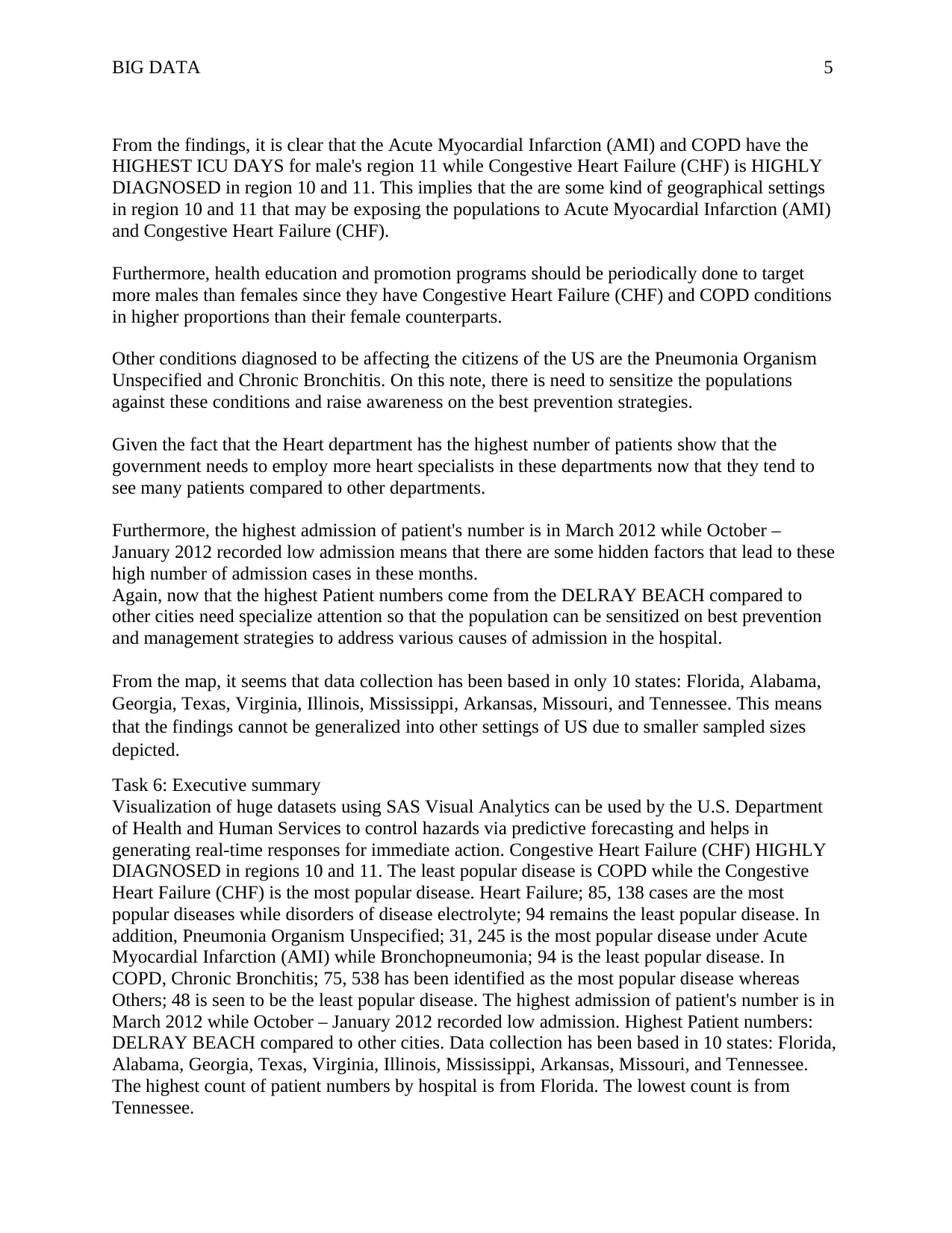
BIG DATA 5
From the findings, it is clear that the Acute Myocardial Infarction (AMI) and COPD have the
HIGHEST ICU DAYS for male's region 11 while Congestive Heart Failure (CHF) is HIGHLY
DIAGNOSED in region 10 and 11. This implies that the are some kind of geographical settings
in region 10 and 11 that may be exposing the populations to Acute Myocardial Infarction (AMI)
and Congestive Heart Failure (CHF).
Furthermore, health education and promotion programs should be periodically done to target
more males than females since they have Congestive Heart Failure (CHF) and COPD conditions
in higher proportions than their female counterparts.
Other conditions diagnosed to be affecting the citizens of the US are the Pneumonia Organism
Unspecified and Chronic Bronchitis. On this note, there is need to sensitize the populations
against these conditions and raise awareness on the best prevention strategies.
Given the fact that the Heart department has the highest number of patients show that the
government needs to employ more heart specialists in these departments now that they tend to
see many patients compared to other departments.
Furthermore, the highest admission of patient's number is in March 2012 while October –
January 2012 recorded low admission means that there are some hidden factors that lead to these
high number of admission cases in these months.
Again, now that the highest Patient numbers come from the DELRAY BEACH compared to
other cities need specialize attention so that the population can be sensitized on best prevention
and management strategies to address various causes of admission in the hospital.
From the map, it seems that data collection has been based in only 10 states: Florida, Alabama,
Georgia, Texas, Virginia, Illinois, Mississippi, Arkansas, Missouri, and Tennessee. This means
that the findings cannot be generalized into other settings of US due to smaller sampled sizes
depicted.
Task 6: Executive summary
Visualization of huge datasets using SAS Visual Analytics can be used by the U.S. Department
of Health and Human Services to control hazards via predictive forecasting and helps in
generating real-time responses for immediate action. Congestive Heart Failure (CHF) HIGHLY
DIAGNOSED in regions 10 and 11. The least popular disease is COPD while the Congestive
Heart Failure (CHF) is the most popular disease. Heart Failure; 85, 138 cases are the most
popular diseases while disorders of disease electrolyte; 94 remains the least popular disease. In
addition, Pneumonia Organism Unspecified; 31, 245 is the most popular disease under Acute
Myocardial Infarction (AMI) while Bronchopneumonia; 94 is the least popular disease. In
COPD, Chronic Bronchitis; 75, 538 has been identified as the most popular disease whereas
Others; 48 is seen to be the least popular disease. The highest admission of patient's number is in
March 2012 while October – January 2012 recorded low admission. Highest Patient numbers:
DELRAY BEACH compared to other cities. Data collection has been based in 10 states: Florida,
Alabama, Georgia, Texas, Virginia, Illinois, Mississippi, Arkansas, Missouri, and Tennessee.
The highest count of patient numbers by hospital is from Florida. The lowest count is from
Tennessee.
From the findings, it is clear that the Acute Myocardial Infarction (AMI) and COPD have the
HIGHEST ICU DAYS for male's region 11 while Congestive Heart Failure (CHF) is HIGHLY
DIAGNOSED in region 10 and 11. This implies that the are some kind of geographical settings
in region 10 and 11 that may be exposing the populations to Acute Myocardial Infarction (AMI)
and Congestive Heart Failure (CHF).
Furthermore, health education and promotion programs should be periodically done to target
more males than females since they have Congestive Heart Failure (CHF) and COPD conditions
in higher proportions than their female counterparts.
Other conditions diagnosed to be affecting the citizens of the US are the Pneumonia Organism
Unspecified and Chronic Bronchitis. On this note, there is need to sensitize the populations
against these conditions and raise awareness on the best prevention strategies.
Given the fact that the Heart department has the highest number of patients show that the
government needs to employ more heart specialists in these departments now that they tend to
see many patients compared to other departments.
Furthermore, the highest admission of patient's number is in March 2012 while October –
January 2012 recorded low admission means that there are some hidden factors that lead to these
high number of admission cases in these months.
Again, now that the highest Patient numbers come from the DELRAY BEACH compared to
other cities need specialize attention so that the population can be sensitized on best prevention
and management strategies to address various causes of admission in the hospital.
From the map, it seems that data collection has been based in only 10 states: Florida, Alabama,
Georgia, Texas, Virginia, Illinois, Mississippi, Arkansas, Missouri, and Tennessee. This means
that the findings cannot be generalized into other settings of US due to smaller sampled sizes
depicted.
Task 6: Executive summary
Visualization of huge datasets using SAS Visual Analytics can be used by the U.S. Department
of Health and Human Services to control hazards via predictive forecasting and helps in
generating real-time responses for immediate action. Congestive Heart Failure (CHF) HIGHLY
DIAGNOSED in regions 10 and 11. The least popular disease is COPD while the Congestive
Heart Failure (CHF) is the most popular disease. Heart Failure; 85, 138 cases are the most
popular diseases while disorders of disease electrolyte; 94 remains the least popular disease. In
addition, Pneumonia Organism Unspecified; 31, 245 is the most popular disease under Acute
Myocardial Infarction (AMI) while Bronchopneumonia; 94 is the least popular disease. In
COPD, Chronic Bronchitis; 75, 538 has been identified as the most popular disease whereas
Others; 48 is seen to be the least popular disease. The highest admission of patient's number is in
March 2012 while October – January 2012 recorded low admission. Highest Patient numbers:
DELRAY BEACH compared to other cities. Data collection has been based in 10 states: Florida,
Alabama, Georgia, Texas, Virginia, Illinois, Mississippi, Arkansas, Missouri, and Tennessee.
The highest count of patient numbers by hospital is from Florida. The lowest count is from
Tennessee.
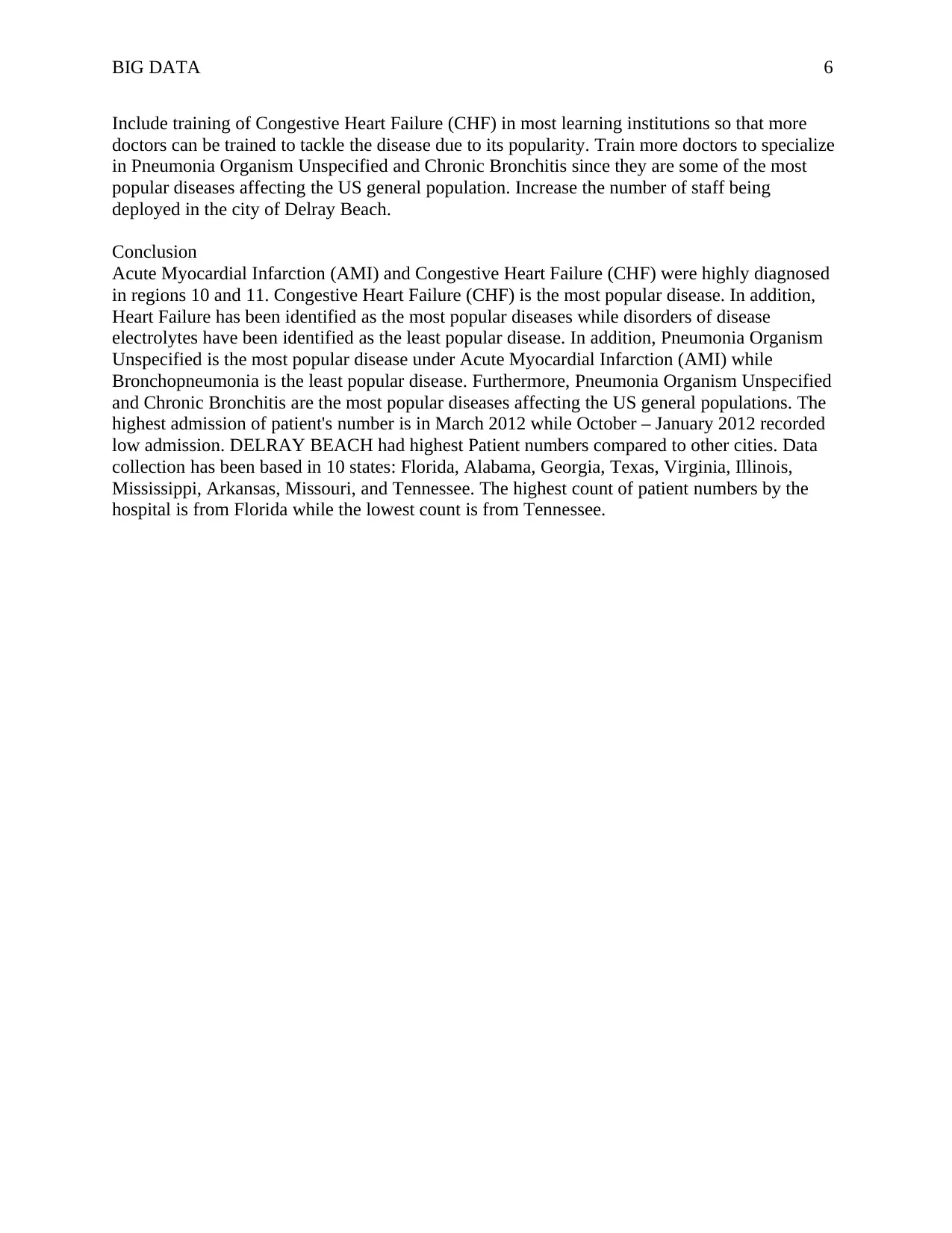
BIG DATA 6
Include training of Congestive Heart Failure (CHF) in most learning institutions so that more
doctors can be trained to tackle the disease due to its popularity. Train more doctors to specialize
in Pneumonia Organism Unspecified and Chronic Bronchitis since they are some of the most
popular diseases affecting the US general population. Increase the number of staff being
deployed in the city of Delray Beach.
Conclusion
Acute Myocardial Infarction (AMI) and Congestive Heart Failure (CHF) were highly diagnosed
in regions 10 and 11. Congestive Heart Failure (CHF) is the most popular disease. In addition,
Heart Failure has been identified as the most popular diseases while disorders of disease
electrolytes have been identified as the least popular disease. In addition, Pneumonia Organism
Unspecified is the most popular disease under Acute Myocardial Infarction (AMI) while
Bronchopneumonia is the least popular disease. Furthermore, Pneumonia Organism Unspecified
and Chronic Bronchitis are the most popular diseases affecting the US general populations. The
highest admission of patient's number is in March 2012 while October – January 2012 recorded
low admission. DELRAY BEACH had highest Patient numbers compared to other cities. Data
collection has been based in 10 states: Florida, Alabama, Georgia, Texas, Virginia, Illinois,
Mississippi, Arkansas, Missouri, and Tennessee. The highest count of patient numbers by the
hospital is from Florida while the lowest count is from Tennessee.
Include training of Congestive Heart Failure (CHF) in most learning institutions so that more
doctors can be trained to tackle the disease due to its popularity. Train more doctors to specialize
in Pneumonia Organism Unspecified and Chronic Bronchitis since they are some of the most
popular diseases affecting the US general population. Increase the number of staff being
deployed in the city of Delray Beach.
Conclusion
Acute Myocardial Infarction (AMI) and Congestive Heart Failure (CHF) were highly diagnosed
in regions 10 and 11. Congestive Heart Failure (CHF) is the most popular disease. In addition,
Heart Failure has been identified as the most popular diseases while disorders of disease
electrolytes have been identified as the least popular disease. In addition, Pneumonia Organism
Unspecified is the most popular disease under Acute Myocardial Infarction (AMI) while
Bronchopneumonia is the least popular disease. Furthermore, Pneumonia Organism Unspecified
and Chronic Bronchitis are the most popular diseases affecting the US general populations. The
highest admission of patient's number is in March 2012 while October – January 2012 recorded
low admission. DELRAY BEACH had highest Patient numbers compared to other cities. Data
collection has been based in 10 states: Florida, Alabama, Georgia, Texas, Virginia, Illinois,
Mississippi, Arkansas, Missouri, and Tennessee. The highest count of patient numbers by the
hospital is from Florida while the lowest count is from Tennessee.
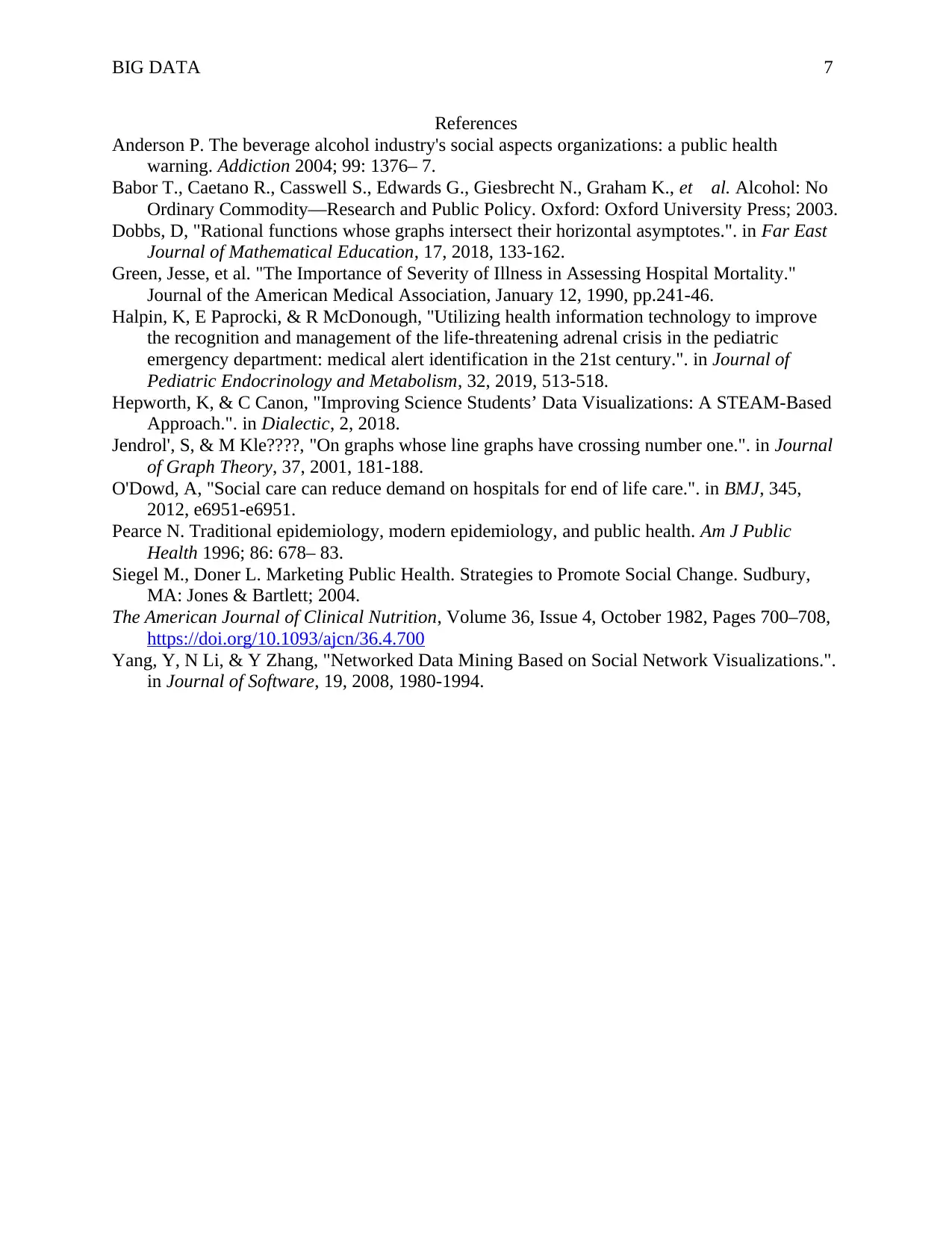
BIG DATA 7
References
Anderson P. The beverage alcohol industry's social aspects organizations: a public health
warning. Addiction 2004; 99: 1376– 7.
Babor T., Caetano R., Casswell S., Edwards G., Giesbrecht N., Graham K., et al. Alcohol: No
Ordinary Commodity—Research and Public Policy. Oxford: Oxford University Press; 2003.
Dobbs, D, "Rational functions whose graphs intersect their horizontal asymptotes.". in Far East
Journal of Mathematical Education, 17, 2018, 133-162.
Green, Jesse, et al. "The Importance of Severity of Illness in Assessing Hospital Mortality."
Journal of the American Medical Association, January 12, 1990, pp.241-46.
Halpin, K, E Paprocki, & R McDonough, "Utilizing health information technology to improve
the recognition and management of the life-threatening adrenal crisis in the pediatric
emergency department: medical alert identification in the 21st century.". in Journal of
Pediatric Endocrinology and Metabolism, 32, 2019, 513-518.
Hepworth, K, & C Canon, "Improving Science Students’ Data Visualizations: A STEAM-Based
Approach.". in Dialectic, 2, 2018.
Jendrol', S, & M Kle????, "On graphs whose line graphs have crossing number one.". in Journal
of Graph Theory, 37, 2001, 181-188.
O'Dowd, A, "Social care can reduce demand on hospitals for end of life care.". in BMJ, 345,
2012, e6951-e6951.
Pearce N. Traditional epidemiology, modern epidemiology, and public health. Am J Public
Health 1996; 86: 678– 83.
Siegel M., Doner L. Marketing Public Health. Strategies to Promote Social Change. Sudbury,
MA: Jones & Bartlett; 2004.
The American Journal of Clinical Nutrition, Volume 36, Issue 4, October 1982, Pages 700–708,
https://doi.org/10.1093/ajcn/36.4.700
Yang, Y, N Li, & Y Zhang, "Networked Data Mining Based on Social Network Visualizations.".
in Journal of Software, 19, 2008, 1980-1994.
References
Anderson P. The beverage alcohol industry's social aspects organizations: a public health
warning. Addiction 2004; 99: 1376– 7.
Babor T., Caetano R., Casswell S., Edwards G., Giesbrecht N., Graham K., et al. Alcohol: No
Ordinary Commodity—Research and Public Policy. Oxford: Oxford University Press; 2003.
Dobbs, D, "Rational functions whose graphs intersect their horizontal asymptotes.". in Far East
Journal of Mathematical Education, 17, 2018, 133-162.
Green, Jesse, et al. "The Importance of Severity of Illness in Assessing Hospital Mortality."
Journal of the American Medical Association, January 12, 1990, pp.241-46.
Halpin, K, E Paprocki, & R McDonough, "Utilizing health information technology to improve
the recognition and management of the life-threatening adrenal crisis in the pediatric
emergency department: medical alert identification in the 21st century.". in Journal of
Pediatric Endocrinology and Metabolism, 32, 2019, 513-518.
Hepworth, K, & C Canon, "Improving Science Students’ Data Visualizations: A STEAM-Based
Approach.". in Dialectic, 2, 2018.
Jendrol', S, & M Kle????, "On graphs whose line graphs have crossing number one.". in Journal
of Graph Theory, 37, 2001, 181-188.
O'Dowd, A, "Social care can reduce demand on hospitals for end of life care.". in BMJ, 345,
2012, e6951-e6951.
Pearce N. Traditional epidemiology, modern epidemiology, and public health. Am J Public
Health 1996; 86: 678– 83.
Siegel M., Doner L. Marketing Public Health. Strategies to Promote Social Change. Sudbury,
MA: Jones & Bartlett; 2004.
The American Journal of Clinical Nutrition, Volume 36, Issue 4, October 1982, Pages 700–708,
https://doi.org/10.1093/ajcn/36.4.700
Yang, Y, N Li, & Y Zhang, "Networked Data Mining Based on Social Network Visualizations.".
in Journal of Software, 19, 2008, 1980-1994.
Paraphrase This Document
Need a fresh take? Get an instant paraphrase of this document with our AI Paraphraser
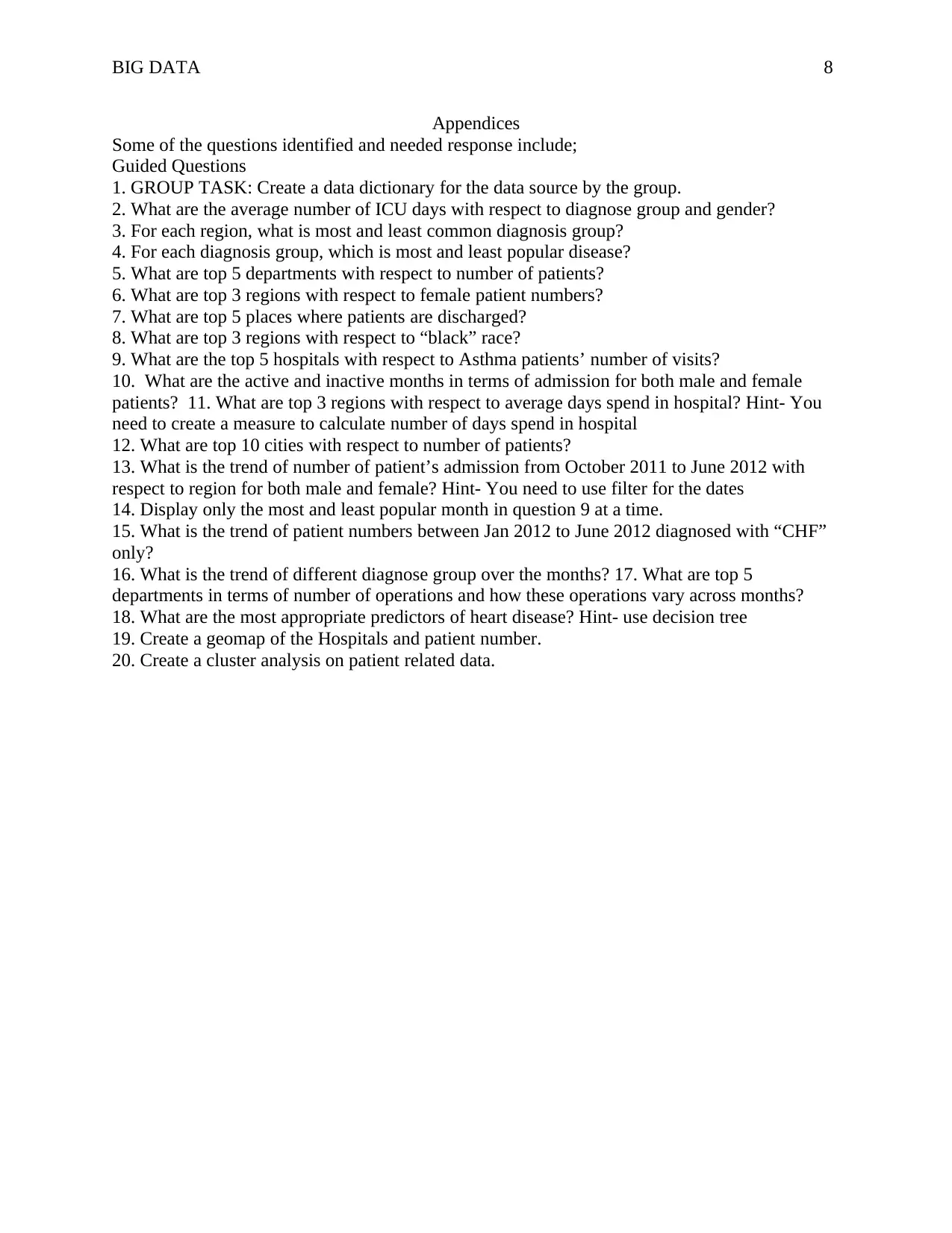
BIG DATA 8
Appendices
Some of the questions identified and needed response include;
Guided Questions
1. GROUP TASK: Create a data dictionary for the data source by the group.
2. What are the average number of ICU days with respect to diagnose group and gender?
3. For each region, what is most and least common diagnosis group?
4. For each diagnosis group, which is most and least popular disease?
5. What are top 5 departments with respect to number of patients?
6. What are top 3 regions with respect to female patient numbers?
7. What are top 5 places where patients are discharged?
8. What are top 3 regions with respect to “black” race?
9. What are the top 5 hospitals with respect to Asthma patients’ number of visits?
10. What are the active and inactive months in terms of admission for both male and female
patients? 11. What are top 3 regions with respect to average days spend in hospital? Hint- You
need to create a measure to calculate number of days spend in hospital
12. What are top 10 cities with respect to number of patients?
13. What is the trend of number of patient’s admission from October 2011 to June 2012 with
respect to region for both male and female? Hint- You need to use filter for the dates
14. Display only the most and least popular month in question 9 at a time.
15. What is the trend of patient numbers between Jan 2012 to June 2012 diagnosed with “CHF”
only?
16. What is the trend of different diagnose group over the months? 17. What are top 5
departments in terms of number of operations and how these operations vary across months?
18. What are the most appropriate predictors of heart disease? Hint- use decision tree
19. Create a geomap of the Hospitals and patient number.
20. Create a cluster analysis on patient related data.
Appendices
Some of the questions identified and needed response include;
Guided Questions
1. GROUP TASK: Create a data dictionary for the data source by the group.
2. What are the average number of ICU days with respect to diagnose group and gender?
3. For each region, what is most and least common diagnosis group?
4. For each diagnosis group, which is most and least popular disease?
5. What are top 5 departments with respect to number of patients?
6. What are top 3 regions with respect to female patient numbers?
7. What are top 5 places where patients are discharged?
8. What are top 3 regions with respect to “black” race?
9. What are the top 5 hospitals with respect to Asthma patients’ number of visits?
10. What are the active and inactive months in terms of admission for both male and female
patients? 11. What are top 3 regions with respect to average days spend in hospital? Hint- You
need to create a measure to calculate number of days spend in hospital
12. What are top 10 cities with respect to number of patients?
13. What is the trend of number of patient’s admission from October 2011 to June 2012 with
respect to region for both male and female? Hint- You need to use filter for the dates
14. Display only the most and least popular month in question 9 at a time.
15. What is the trend of patient numbers between Jan 2012 to June 2012 diagnosed with “CHF”
only?
16. What is the trend of different diagnose group over the months? 17. What are top 5
departments in terms of number of operations and how these operations vary across months?
18. What are the most appropriate predictors of heart disease? Hint- use decision tree
19. Create a geomap of the Hospitals and patient number.
20. Create a cluster analysis on patient related data.
1 out of 8
Related Documents
Your All-in-One AI-Powered Toolkit for Academic Success.
+13062052269
info@desklib.com
Available 24*7 on WhatsApp / Email
![[object Object]](/_next/static/media/star-bottom.7253800d.svg)
Unlock your academic potential
© 2024 | Zucol Services PVT LTD | All rights reserved.





